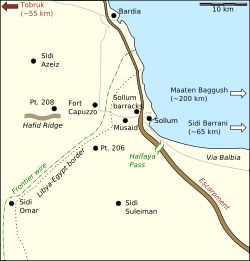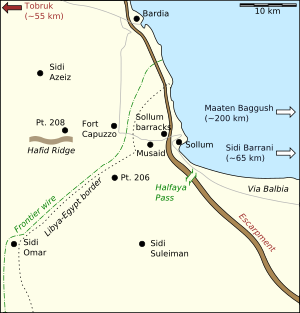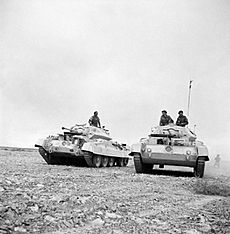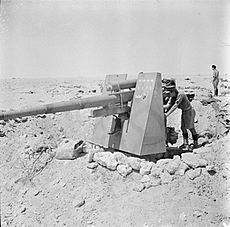Operation Skorpion facts for kids
Quick facts for kids Operation Scorpion/Unternehmen Skorpion |
|||||||||
|---|---|---|---|---|---|---|---|---|---|
| Part of the Western Desert Campaign of the Second World War | |||||||||
 The area of fighting from 24 March – 17 June 1941 |
|||||||||
|
|||||||||
| Belligerents | |||||||||
| Commanders and leaders | |||||||||
| Strength | |||||||||
| Infantry battalion and supporting arms | Kampfgruppe von Herff | ||||||||
| Casualties and losses | |||||||||
| 173 men 12 guns 5 Infantry tanks |
|||||||||
Operation Skorpion (also known as Unternehmen Skorpion) was a short but important military operation. It happened on May 26–27, 1941, during World War II. This battle was part of the Western Desert Campaign in North Africa.
The fight was between the Axis forces, led by Colonel Maximilian von Herff from Germany, and British forces, led by Lieutenant-General William "Strafer" Gott. The Axis forces launched a surprise attack. Their goal was to take back Halfaya Pass in north-western Egypt. The British had captured this pass just days before during Operation Brevity.
Operation Skorpion was successful for the Axis. They pushed the British out of Halfaya Pass. The British had to retreat to areas further east. After taking the pass, German and Italian soldiers built strong defenses there. They set up special areas to destroy enemy tanks. This was to prepare for any new British attacks. The British then planned another big attack called Operation Battleaxe. However, this operation also failed and cost the British many soldiers and tanks. This led to big changes in the British command. General Sir Archibald Wavell, the top commander in the Middle East, was replaced.
Contents
Why the Battle Happened
The Desert War Begins
The war in the Western Desert was tough. After the British won against the Italian army in Operation Compass, Germany sent help. They sent the Deutsches Afrika Korps (DAK) to Libya. This force was led by Erwin Rommel, a famous German general.
Rommel quickly attacked the British. He pushed them back across the Egyptian border. But the British held onto the port city of Tobruk. This city was very important. A long siege began there. Rommel's forces advanced far but faced problems. They ran out of water and fuel. This made it hard for them to go further into Egypt. The British used this time to get stronger in Egypt.
Halfaya Pass: A Key Location
The Western Desert is a huge, flat, stony area. It stretches for hundreds of miles. There are not many places where vehicles can easily cross. Halfaya Pass is one of these important gaps. It's a natural opening in a steep cliff near Sollum, about one kilometer inland.
In Operation Brevity, the British attacked through Halfaya Pass. They wanted to reach areas beyond Fort Capuzzo in Libya. The British captured Halfaya Pass. It was taken by the 2nd Battalion Scots Guards. Then, the 3rd Battalion Coldstream Guards defended it. They had tanks, anti-tank guns, and anti-aircraft guns.
Getting Ready for Battle
Operation Brevity: A Quick Attack
Operation Brevity was a quick British attack. It aimed to hit weak Axis forces near the Egyptian–Libyan border. The British wanted to capture land. They also wanted to hurt the German and Italian forces. On May 15, the British attacked with infantry and tanks.
They took Halfaya Pass from the Italians. They also captured Fort Capuzzo in Libya. But German counter-attacks quickly took back Fort Capuzzo. The British faced heavy losses. German reinforcements arrived from Tobruk. The British commander, Gott, worried his forces would be trapped. So, he ordered a planned retreat. By May 16, the British pulled back to Halfaya Pass.
The German Plan: Operation Skorpion
The Germans planned Unternehmen Skorpion to take back Halfaya Pass. Their idea was to trick the British into leaving. They would make it look like a huge attack was coming. The German force was called Kampfgruppe von Herff. It included tanks and infantry.
They had many tanks, but not enough fuel for all of them. Only about 70 tanks were used. The German force split into groups. One group would make a wide move to the right. Another group with most of the tanks would attack the center. A third group would attack near the coast. If the British stayed, the main tank groups would join up for a big attack.
The Battle of Halfaya Pass
On the evening of May 26, the German Kampfgruppe von Herff gathered near Halfaya Pass. They attacked the next morning. Their first goal was to trick the British. A tank battalion moved as a decoy. This made the British think a large attack was coming from the desert side.
Only one German group met strong resistance at first. In the afternoon, the German commander, Herff, ordered his tanks to move north. They were to defeat the British at Halfaya Pass. This move happened during the night. At dawn on May 27, the Germans attacked the pass from different sides. Their tanks appeared on top of the cliff. They fired down onto the coastal plain.
The British tanks at Halfaya tried to fight back. But their commander, Gott, soon allowed them to retreat. The British soldiers managed to escape. However, some Guards were captured by the Germans at the bottom of the pass. There were no British forces close enough to help. So, the Axis troops quickly took back Halfaya Pass.
After the Battle
Losses
The British lost 173 soldiers. They also lost 12 guns and 5 tanks. The German commander, Herff, reported capturing 40 prisoners. He also said they took 9 field guns and 7 British Matilda tanks.
New Tanks Arrive
On May 12, a special convoy of ships arrived in Alexandria, Egypt. It brought many new tanks and fighter planes for the British. There were 238 tanks and 43 Hawker Hurricane fighters. This included 50 new Crusader tanks. These tanks were meant for the British 7th Armoured Division. This division had been out of action because most of its tanks were worn out. There were some delays in getting the new tanks ready for desert fighting. So, the next big British attack, Operation Battleaxe, was delayed.
What Happened Next
Axis Defenses
After taking back Halfaya Pass, the Axis forces built strong defenses. They dug in their powerful 88 mm guns and 50 mm anti-tank guns. These guns were hidden and ready to fire in all directions. They even used turrets from destroyed British tanks. These were dug into the ground. The bottom of the pass was also filled with landmines.
The Germans placed five of their powerful 88 mm guns at Halfaya. These guns were very effective against tanks. Four more 88 mm guns were dug in behind minefields at other key locations. Even with fewer soldiers, it was hard to supply these defenses with water, fuel, and ammunition.
Operation Battleaxe
On June 15, the British launched Operation Battleaxe. They wanted to destroy the Axis forces at Halfaya Pass and other areas. Then, they planned to capture Tobruk and move further west. However, the Germans knew about the British plan. They even used captured documents during the battle.
On June 17, the British were ordered to retreat. They pulled back to their starting positions. The British suffered heavy losses. They lost 969 soldiers and many tanks. The Germans lost 678 men and 12 tanks. Many more German tanks were damaged but repaired. The British also captured about 350 Italian soldiers.
After this failure, the British command changed again. General Wavell was replaced by General Claude Auchinleck.
More to Explore
- North African campaign timeline
- List of World War II Battles
- List of German military equipment of World War II
- List of British military equipment of World War II




